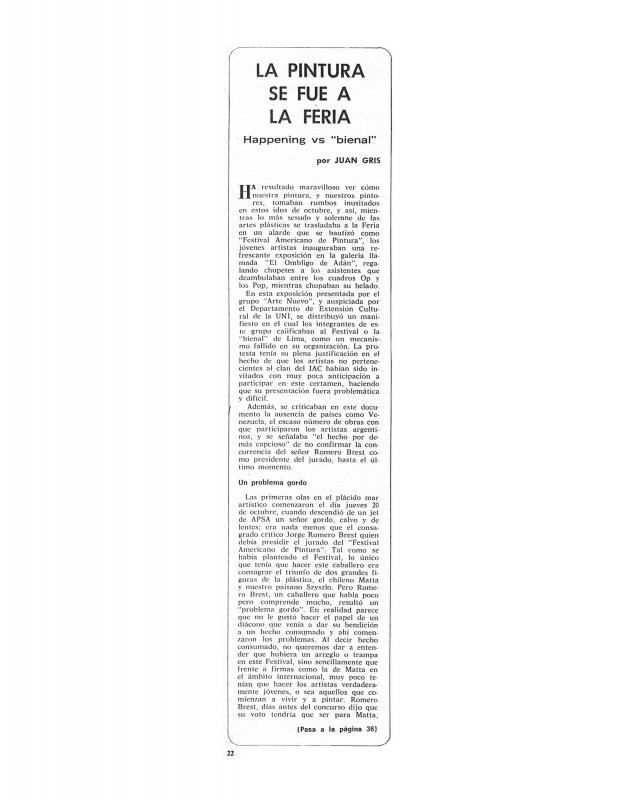On opening night the writer and artist Felipe Buendía (1927–2002) starred in one of the first happenings ever staged in Lima: dressed as the president of the country he gave a sarcastic speech and then handed out popsicles and candy.
Also known as the I Bienal de Lima or the Bienal de la Feria del Pacífico (named for the location of the competition), the Festival Americano de Pintura took place in October–November 1966 [see also the following article in the ICAA digital archive: “El Festival Americano de Pintura” by Luis Antonio Meza (doc. no. 1142611)]. The jury was presided over by the Argentinean critic Jorge Romero Brest (1905–89), as well as the Venezuelan collector Inocente Palacios and the Peruvian architect Luis Miró Quesada Garland (1914–94). Despite the former’s negative vote, the Grand Prize was awarded to the Chilean painter Roberto Matta (1911–2002). The festival’s organization and results stirred controversies and prompted belligerent opposition led by Arte Nuevo, a group of young artists who had not been invited. This event caused a break between generations, pitting an experimentally inclined young avant-garde against the hallowed language of the great exponents of Latin American modernism that was promoted locally by the IAC (Instituto de Arte Contemporáneo).
The following artists were originally members of the Grupo Señal and went on to form the Arte Nuevo group: Luis Arias Vera (1932–2016), Gloria Gómez-Sánchez (1921–2007), Teresa Burga (b. 1935), Jaime Dávila (b. 1937), Víctor Delfín (b. 1927), Emilio Hernández Saavedra (b. 1940), José Tang (1941–2006), Armando Varela (b. 1933), and Luis Zevallos Hetzel (b. 1933). They started out by installing their works of art in an abandoned illuminated sign store in the historical center of Lima—just a few meters from the Plaza Mayor and the government palace—which they transformed into an improvised gallery they called El ombligo de Adán. This exhibition, which included plenty of Pop Art, Op Art, and installations, was an important step for new Peruvian art movements, especially in terms of its challenge to so-called “traditional” art.
[On the subject of the Grupo Arte Nuevo, see the following articles in the ICAA digital archive: by Luis Freire “De cómo el Gral. Velasco reventó el ‘¡Pop! Art’” (doc. no. 1139323); by Juan Acha “Espíritu renovador: exposición del Grupo “Arte Nuevo’” (doc. no. 1142771); (anonymous) “Exagerado sentido realista: Exposición de Luis Arias Vera” (doc. no. 1142510); by Mario Belaúnde Guinassi (under the pseudonym “Juan Gris”) “La nueva imagen del IAC” (doc. no. 1142594) and “La pintura se fue a la feria: happening vs ‘bienal’” (doc. no. 1142737); by Felipe Buendía “Mala noche de Buendía” (doc. no. 1142628) and “Resentido social” (doc. no. 1142644); by the Grupo Arte Nuevo (untitled) [“Nos encontramos en un mundo determinado...”] (doc. no. 1142834); (anonymous) “Op-Pop-Sex” (doc. no. 1142804); and (anonymous) “Treinta minutos de charla con la señora Gloria Benvenuto de Gómez Sánchez, nuevo valor de la Pintura Nacional” (doc. no. 1142413)].











